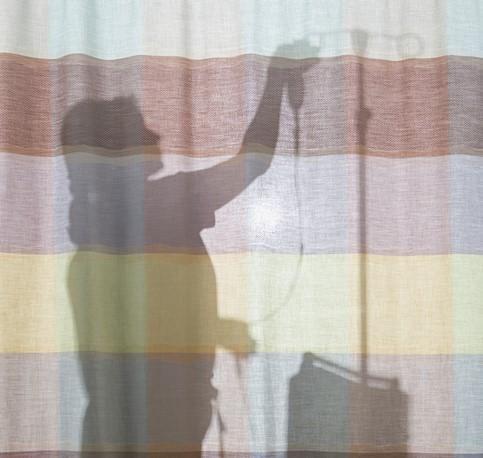A new study by researchers from the University of Michigan Medical Center has found that contamination of patient privacy curtains by multidrug-resistant organisms (MDROs) is common, and that the high-touch surfaces could be a source of MDRO transmission to patients.
The study will be presented at the upcoming meeting of the European Congress of Clinical Microbiology and Infectious Diseases (ECCMID) in Amsterdam.
The study's lead author said the findings, which revealed that more than one in five cultures taken from patient privacy curtains at skilled nursing facilities (SNFs) was contaminated with MDROs, are a concern because of how often these surfaces are touched by patients and healthcare workers, how ubiquitous they are in healthcare facilities, and how infrequently they are cleaned.
"Healthcare textiles and soft surfaces often fly under the radar," Lona Mody, MD, MSc, a geriatrician at the University of Michigan Medical Center, told CIDRAP News. "Curtains are an issue because it is really required to touch them in order to move them…and healthcare workers are likely to touch the curtains after they do hand hygiene and before they see the patient."
VRE, MRSA, and resistant gram-negatives
For the prospective cohort study, conducted at six SNFs in southeastern Michigan, Mody and her colleagues obtained cultures from patient body sites and high-touch surfaces on the day patients were admitted and on days 14, 30, and then monthly for up to 6 months.
The patient population mostly consisted of those on short-stay admissions (average length of 22 days) recovering from acute-care hospitalization. A total of 1,521 samples from privacy curtains in 625 rooms were obtained, with the researchers focusing on the edges of the curtains, where they are most frequently touched.
Analysis of the privacy curtain samples found that 334 (22%) tested positive for MDROs, with contamination rates ranging from 11.9% to 28.5% across facilities. The most frequent MDRO detected was vancomycin-resistant enterococci (VRE), which was found in 210 cultures (13.8%). Drug-resistant gram-negative bacteria (including Acinetobacter baumannii, Klebsiella pneumoniae, and Enterobacter cloacae) were found in 94 cultures (6.2%), and methicillin-resistant Staphylococcus aureus (MRSA) was detected in 74 cultures (4.9%).
The proportion of MDROs found on privacy curtains in private rooms (23.1%) and shared rooms (22%) was similar. MDROs were more commonly found on curtains on the day of admission (28.5%) than during the follow-up visits (18.2%). In the rooms where 6-month follow-up data were available, curtain contamination was intermittent.
The study also found an association between patient colonization and curtain contamination. In 15.7% of sampling visits, patients and curtains were carrying the same MDRO at the same time. In the 210 sampling visits during which VRE was detected on privacy curtains, 57.6% of patients were also colonized with VRE. For the 74 visits in which MRSA was detected, 56.7% of patients were colonized with MRSA. On the flip side, in the rooms where MRSA and VRE weren't detected on privacy curtains, 85% and 73.3% of the patients weren't colonized with these pathogens.
Mody said that while she and her colleagues "had some suspicion" of the amount of contamination they would find on the curtains, "this reinforced our suspicion."
The question, however, is which direction the MDROs are being transmitted: from the curtain to the patients, or the other way around? Mody said analysis of a subset of privacy curtains that were newly contaminated with VRE found that 60% of the patients in those rooms were colonized before the curtain was contaminated, while only 5% of curtains were contaminated before VRE was detected in the patients. This suggests patient-to-curtain transmission is more prevalent.
Mody said it would be more troubling if the transmission was going in the other direction. "The concern would be more if we were to find that curtains were always contaminated before the patient was contaminated," she said.
But Mody stressed that the findings need to be replicated using genomic and molecular testing methods, which will provide a clearer idea of directionality and the relationship between the MDROs found on the curtains and the patients. She also noted that healthcare workers coming from other parts of the hospital are touching the curtains as well, so there may not always be a direct connection between the patient and the curtain.
More frequent curtain cleaning
Although more research needs to be done, Mody said the results suggests that regulatory agencies need to establish cleaning frequency and guidance for privacy curtains, and pay more attention to healthcare textiles in general.
The study found that the frequency of changing curtains at the six facilities ranged widely. Some SNFs changed the curtains once a week, while others changed them during deep cleaning or "at least annually or when visibly soiled."
She also suggested there might be a way to redesign the curtains, which she noted can be cumbersome to take off and clean.
"People touch curtains in a very specific place," Mody said. "Maybe we could create a handle that could be removed easily and washed."
In addition, Mody stressed that hand hygiene plays a major role in reducing transmission of dangerous pathogens. "Hand hygiene is important for everyone: patients, visitors, and healthcare providers," she said.
See also:
Apr 13 ECCMID abstract
Apr 13 ECCMID poster

























